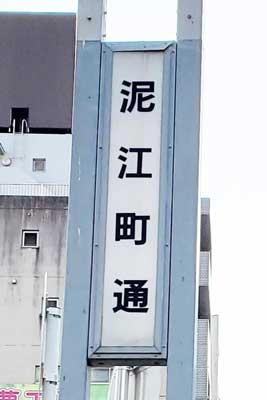2022.04.26

Hijiecho (泥江町) is the name of an intersection, about 600 meters along the Sakura-dōri (桜通) street from Nagoya Station, where the street is intersected by the Egawa Route (江川線). (Nagoya International Center is located on the northeastern corner of the Hijiecho intersection.)

From Hijiecho intersection, a street runs diagonally to the southwest, ending at the Kintetsu Station (近鉄駅前) intersection where you will see the Meitetsu Department Store Men's Annex. This street is called Hijiechō-dōri (泥江町通), or Hijiechō Street.

Hijiechō was formerly the name of the area that developed around Hijiechō-dōri after the street was laid in 1885 to connect the Sakura-dōri to the original Nagoya Station (precursor to the current JR Nagoya Station), located at the southwestern end of Hijiechō-dori before it moved to new facilities at the current (JR Nagoya Station) site in 1937.
The Hijiechō neighborhoods were renamed Meieki (名駅) in 1977, so that now Hijiechō only exists as the name of the intersection.
Let's look at each character in 泥江町 and see if it can tell us anything about the area.
泥 doro (mud; slush; [wet] dirt). Sometimes read as dei in some compounds.
Also found in 泥沼 / doronuma (marsh; swamp; quagmire), 泥棒 / dorobō (thief; burglar)
江 e (river; creek; inlet). Sometimes read as kō or gō in some compounds, e.g. 揚子江 / Yōsukō (Yangtze River in China)
Also found in 蟹江 / Kanie (town in Aichi Prefecture), 江戸 / Edo (historical name for Tokyo)
町 chō / machi (town; block; neighborhood)
This muddy name no doubt puzzles many who are accustomed to the office buildings, restaurants, bars and convenience stores that now occupy the area. But from these characters we can imagine what the area must have been like at the time the first Nagoya Station was built: a swampy inlet.
Incidentally, even Japanese people unfamiliar with the area sometimes attempt to read Hijiechō as Doroechō, as hiji (ひじ or ひぢ) is an archaic reading for 泥.




